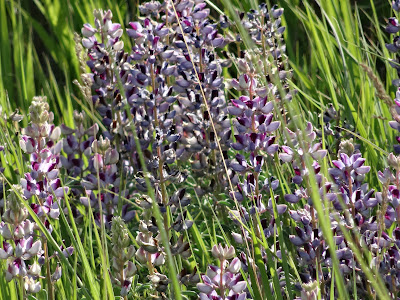Wow. We finally made it to Colorado. It was a fun 1700 miles so far and we still haven't arrived at Bryan's House. Today we leave Cheyenne Wyoming and drive south to the Pawnee Grasslands in search of any longspurs. McCown's is the expected one in the short grass prairie on the western side of the Pawnee Grasslands where we would be entering. Although we drove for miles we weren't able to come across the longspurs. However, we did find a Golden Eagle perched on a telephone pole and three individual Burrowing Owls in various places.
 |
| Golden Eagle |
 |
| Golden Eagle |
 |
| Burrowing Owl |
|
 |
| Burrowing Owl on favorite perch |
Since we weren't expected at Bryan's until 5 o'clock, we headed further southwest to Rocky Mountain National Park. The park is one of my favorites but since it was a Friday before the Fourth of July holiday, the park was jammed with cars making the experience less than optimal. However, there was still plenty of wildlife to be seen. Elk were roaming around in people's yards.
 |
| Elk still with velvet on antlers |
At higher elevations the Golden-mantled Ground Squirrel could be found running among the rocky mountainsides. The golden-mantled ground squirrel can be identified by its chipmunk-like stripes and coloration, but unlike a chipmunk, it lacks any facial stripes.
 |
| Golden-mantled Squirrel |
|
 |
| Colorado Chipmunk(ID note - little brown stripe under the outer white stripe) |
 |
| Clark's Nutcracker (Definitely one of the cooler Jays) |
 |
| Elk at over 11,000 ft elevation |
Due to a good snowfall this past winter the rivers and waterfalls were gushing. This is good for Colorado in general as they were lacking in water the last two years.
 |
| The Alluvial fan |
 |
| Still ten feet of snow along the roadways |
 |
| Snowmelt - not present in the late summer months |
 |
| Above timberline at over 11,000 ft |
A couple of other animals that like the high elevation during the summer months.
 |
| Bighorn Sheep |
 |
| Yellow-bellied Marmot |
After leaving Rocky Mountain National Park we drove about a hour to get to Longmont, CO where Bryan's home in located. That evening we got to play soccer and frisbee with our grandson Ben at the park across the street.
 |
| Ben displays his pet Sphinx Moth |
 |
| Showing off Kitty |
 |
| Ben and Grandmom doing oragami |
Back in December, Sharon told me that Baird's Sparrow had been discovered nesting in Colorado. Her Christmas present to me was this trip to Colorado in search of this sparrow. The Baird's Sparrow normally nest in North Dakota and further north into Canada. So this was a nice find for the state. The next morning, Bryan and I rose at 4:45AM to make the 70 minute drive to Soapstone Prairie Natural Area.
I like to call this the Baird's Sparrow death march as we had to hike 3.5 miles out to the site and then return the same route back to the car. The trail was mostly flat but there were a few hills to traverse. The area was mostly short grass prairie which had me worried since I remember this sparrow in North Dakota in a long grass prairie which I thought was their preferred habitat. We did some birding along the way and by far the most common birds were Horned Larks and Vesper Sparrows. Grasshopper Sparrows made an appearance once in a while also.
 |
| Making the hike- Bryan carrying the tripod and scope |
 |
| Hard to see but this is Bryan with Pronghorn Antelope in background |
 |
| Vesper Sparrow |
We eventually made it to the area after an hour hike. Fortunately it was a cloudy day and rather cool which made the hike bearable. So we started scoping the short grasslands and listening for the call. Instead we found a large nesting area for the McCown's Longspurs that I missed yesterday in the Pawnee Grasslands. We watched them doing their flight displays for about fifteen minutes.
Not having any luck, I finally noticed a distant area where the grass looked a lot taller. So I told Bryan and we hiked over in that direction. As we approached, Bryan could hear the sparrow singing. We set up the scope and scanned the tall grass knowing that this sparrow likes to hunker down. While we were scanning we were being treated to the aerial courtship display of the Wilson's Snipe. The snipe would fly up like a woodcock to about 500 feet. While the snipe stayed in the air it would dive about 200 feet or so towards the ground and make a noise which was caused by the wind flowing through its tail feathers. Impressive. There was also another snipe on the ground somewhere doing their winnowing call.
Getting back to the Baird's Sparrow, after about ten minutes of hearing the singing bird, he finally popped up on a wire mesh and we were able to scope him from a distance of about 200 yards. Not the greatest view but good enough to see the field marks and get my lifer Baird's. Success!!! I actually got to see the sparrow on June 25th exactly 6 months after my Christmas gift.
 |
| That's him - That's the best I could do. Better view was had through scope. |
 |
| Watching my lifer Baird's Sparrow |
 |
Internet Photo of Baird's Sparrow with ID info
That should do it for this trip. I don't want to bore you with the details and stops we made in Kansas and Missouri, so I will stop here. Hope you enjoyed this blog. If you ever get the chance to go to Custer State Park in South Dakota I would highly recommend stopping there. |






















































